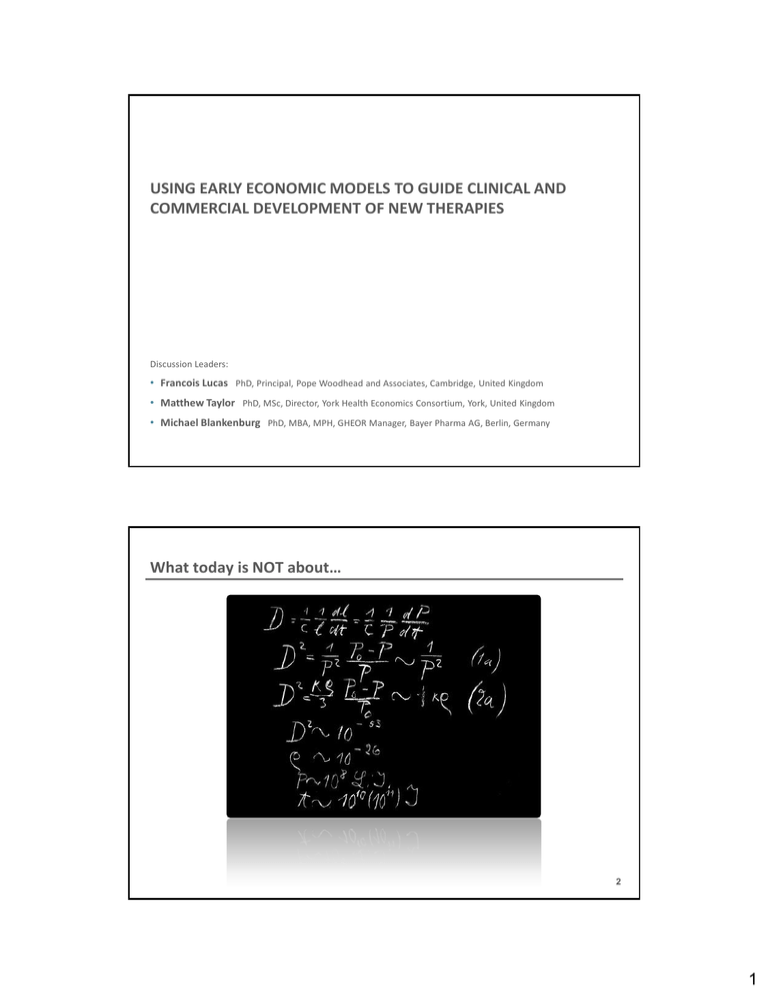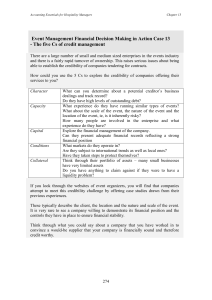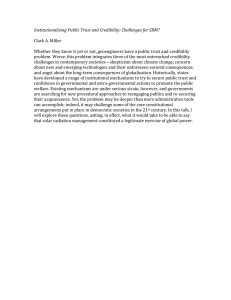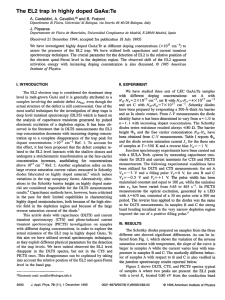Using Early Economic Models to Guide Clinical and
advertisement

USING EARLY ECONOMIC MODELS TO GUIDE CLINICAL AND COMMERCIAL DEVELOPMENT OF NEW THERAPIES Discussion Leaders: • Francois Lucas PhD, Principal, Pope Woodhead and Associates, Cambridge, United Kingdom • Matthew Taylor PhD, MSc, Director, York Health Economics Consortium, York, United Kingdom • Michael Blankenburg PhD, MBA, MPH, GHEOR Manager, Bayer Pharma AG, Berlin, Germany What today is NOT about… 2 1 What today IS about… Understanding why and how early economic models are useful in the clinical and commercial development of new health technologies 3 Agenda • What is an early economic model for and what is it? • Guidance for designing an early model • What does it mean for the pharma company? • Ensuring credibility • Interactive session 4 2 Early models • Early models are: • A useful predictor of the likely cost-effectiveness range • Simple analyses, based on a small number of inputs • Largely driven by exploration of uncertainty and data gaps • A useful tool to direct future research • Early models are not: • Designed to generate ‘accurate’ cost-effectiveness ratios • Focussed on one specific base case • Intended to be presented to authorities to make cases for reimbursement (maybe for research funding, though) 5 An early model is an important source of information for key investment decisions Phase III Phase II Early HE model HEOR PRICING MEDICAL & REGULATORY Global economic model framework Early pricing strategy Phase III design Positioning and market shaping MARKETING 6 3 An early economic model is relatively simple and highly flexible HTA: health technology assessment; NICE: National Institute for Health and Care Excellence 7 An early economic model is exploratory • Have a reputation for being ‘quick and dirty’ • There is no real reason why early models should be less robust than ‘late’ models • However, data availability (and time pressures) often lead to simplified approaches 8 4 Even if we don’t have any data… • Model populated with ‘dummy’ data may still provide valuable insights: • How changes to key inputs affect the results? • What range or combination of outcomes will lead to positive results? • Which parameters are most vital to the model results, hence will require priority research? 9 No reason why early models should differ from ‘late’ models • Modelling disease pathways: i.e. Markov model, decision tree etc. • Handling probabilities: i.e. deterministic, stochastic etc. • Purpose: i.e. cost effectiveness, budget impact etc. In fact, the purpose is often to predict the results of a ‘later’ model… 10 5 Agenda • What is an early economic model for and what is it? • Guidance for designing an early model • What does it mean for the pharma company? • Ensuring credibility • Interactive session 11 Recommended approach to early modelling Scoping the model Review existing HTA models / published models Literature review for supplementary data, if needed Develop and build standard care base case Incorporate differential aspects of new therapy Explore uncertainty and interpret! HTA: health technology assessment 12 6 Dos and don’ts for early modelling • Likely to be an interactive model, so keep it user-friendly • Identify the key purpose of the model • Don’t present one single ‘result’, but avoid ‘over-analysis’ 13 A structured analysis is advised 1 One-way sensitivity analysis Understand the impact of each variable on cost/QALY and economically justified price 2 Key variables identified and carried forward Two-way sensitivity analysis / Probabilistic Understand how key variables interact QALY: quality-adjusted life year; R&D: research and development 3 Key research questions Analysis of multi-variable scenarios Provide strategic recommendati ons for R&D and pricing decisions 14 7 One-way sensitivity analysis • Vary each parameter by a given amount e.g. +/- 10%, 20%, 50% • Examine impact of each change on model’s main outcome • Present as a ‘tornado’ diagram 20 % decrease 20 % increase Incidence of disease Probability of treatment success Probability of comparator success Cost of treatment Cost of comparator Quality of life for health patients Quality of life for patients with disease Discount rate (costs) Discount rate (benefits) -30% -20% -10% 0% 10% 20% 30% 40% Change in ICER (%) 15 ICER: incremental cost-effectiveness ratio Determining an economically justifiable price Price Required To Achieve ICER of £20,000 £16,000 £14,000 Maximum price to be cost-effective Price Required £12,000 £10,000 £8,000 Estimate (based on expert knowledge) £6,000 £4,000 £2,000 £0 0.0 1.0 2.0 3.0 4.0 5.0 6.0 7.0 Additional Survival (Months) 16 8 Two-way analysis Economically justifiable price £/month 300 HF Hosp. RRR (%) 250 200 30 25 20 150 15 10 5 100 0 50 0 0 5 10 15 20 25 30 Mortality RRR % Mortality RRR was found to have much more EJP impact than hospitalization RRR, and the effects were additive RRR: relative risk reduction 17 Scenario analysis • Non-quantitative factors can be uncertain • Choice of comparator • Treatment sequences and Increased cost pathways Scenario 1 • Present results for all likely scenarios Scenario 2 Loss of QALYs Scenario 3 Gain in QALYs Scenario 4 Decreased cost 18 9 Target Indications Max price (determine by model) Population Gross sales £100 100,000 £10,000,000 All patients Optimal indication Patients with risk factor A £175 70,000 Optimal revenue £12,250,000 Patients with risk factor B £255 45,000 £11,475,000 Patients with risk factor A and B £320 17,000 £5,440,000 Trade-off between ‘max’ price and population size 19 Agenda • What is an early economic model for and what is it? • Guidance for designing an early model • What does it mean for the pharma company? • Ensuring credibility • Interactive session 20 10 Ensure relevant functions are engaged throughout the project Structured Literature search Alignment workshop Model development and analysis External research / validation MODEL SPECIFICATION Alignment Workshop Reporting FINDINGS AND IMPLICATIONS Input: • • • • Regulatory Affaires Expert insights Quantitative assumptions Data sanity check Buy-in Clinical Development Medical Affairs Strategic Marketing 21 Key elements of payer evidence strategy Payer Insights Clinical Development Economic Models Real Life Evidence (RLE) Patient Reported Outcomes (from Trials or RLE) • Efficacy • Safety • Cost-Effectiveness • Budget impact • Societal impact and burden • Effectiveness / relative effectiveness • Cost and resource use • Adherence, convenience, administration • Symptom & functional improvement • Quality of life • Health utilities, preferences Payer Value Substantiation Evidence strategy must go beyond clinical development to substantiate value 22 11 Early HE model is an important source of information for early key investment decisions The early HE model informs internal customers (clinical, marketing, pricing) while the later full HE informs external stakeholders (payers, providers, HTAs) Function Key decision & deliverable Information to guide decision Clinical & Regulatory Design of RCT Range of events, endpoints that drive value Marketing Develop value proposition and positioning strategies Stakeholders’ drivers and barriers Pricing Establish reimbursable international price Impact of target product profile on price potential (EJP) Market Access Create and communicate value evidence Impact of treatment on health gain and costs; evidence scenarios 23 Ensure outputs are appropriately implemented by other functional teams Clinical & Regulatory teams Pricing team HE evidence team Marketing & Advocacy Implementation: • • • Best informed guidance to the functions’ own benefit Optimal evidence generation early on Impactful evidence communication • Phase 3 RCT to optimally capture endpoints • Informed early pricing strategy • Key endpoints • PRO • RLE • Product positioning • Value proposition 24 12 Identified value drivers inform the overall evidence generation process • Reduction of all-cause mortality is the largest single driver of EJP • Reduction of hospitalization rate had a clearly lower EJP impact. Mortality and hospitalization benefits are correlated, and combined effects drive the EJP • Reductions in the risk of drug-specific adverse events could impact EJP mainly in an indirect way – a better safety profile would lead to less discontinuation and increase overall treatment effectiveness, leading to a higher EJP 25 Identified value drivers inform the clinical evidence generation process • Carefully assess the potential impact of the phase 3 trial design (inclusion/exclusion criteria, dosing, powering etc.) on the chances to show a significant and sizeable survival benefit while preserving a superior safety profile • Consider an open label extension to better capture mortality reduction and track quality of life in the long run to demonstrate that treatment’s benefit on hospitalization rate predicts mortality benefit beyond the trial period • Plan stratified analyses of the phase 3 data based on risk of frequent/long/costly hospitalizations and of drug-related adverse events 26 13 Identified value drivers inform the health economic evidence generation process • Analyze patterns and cost components of hospitalizations across the various markets, and identify the subpopulation of ‘high hospitalization cost’ patients • Quantify the extent to which real or perceived risk of severe adverse events triggers discontinuation or (very) low dosing • Quantify the loss of effectiveness of current drugs due to discontinuation and down dosing • Explore value-added services to support patients (helping survivors to have a good quality of life) and physicians (helping them to manage adverse events with confidence) 27 Agenda • What is an early economic model for and what is it? • Guidance for designing an early model • What does it mean for the pharma company? • Ensuring credibility • Interactive session 28 14 Why credibility is important • Early models have been around for some time • Useful but still rarely used • This is probably due to misunderstanding about their purpose… • …and perceptions they are not real and credible • This can be addressed by: • Persistent effort in engaging and communicating cross-functionally • Technical credibility • Adequate clinical and payer insight (clinical/market credibility) 29 Making sense of the model: alignment with clinical practice • At least one KOL per key market to cover different health systems to: • Validate key elements of disease modelling • Check that ranges tested for endpoints/model parameters are clinically feasible • Identify the appropriate comparators • Obtain an independent, qualitative view of the most important value drivers KOL: key opinion leader 30 15 Agenda • What is an early economic model for and what is it? • Guidance for designing an early model • What does it mean for the pharma company? • Ensuring credibility • Interactive session 31 16




